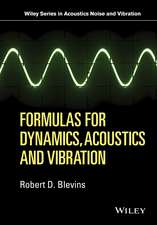Non-Linear Theory of Elasticity and Optimal Design
Autor L.W. Ratneren Limba Engleză Hardback – 11 noi 2003
Preț: 964.31 lei
Preț vechi: 1320.97 lei
-27% Nou
Puncte Express: 1446
Preț estimativ în valută:
184.52€ • 192.28$ • 152.78£
184.52€ • 192.28$ • 152.78£
Carte tipărită la comandă
Livrare economică 03-17 aprilie
Preluare comenzi: 021 569.72.76
Specificații
ISBN-13: 9780444514271
ISBN-10: 0444514279
Pagini: 279
Dimensiuni: 156 x 234 x 18 mm
Greutate: 0.58 kg
Editura: ELSEVIER SCIENCE
ISBN-10: 0444514279
Pagini: 279
Dimensiuni: 156 x 234 x 18 mm
Greutate: 0.58 kg
Editura: ELSEVIER SCIENCE
Cuprins
Introduction.Prologue.PART I.Developing the reliable theory for optimal structure. The practical problems. Foundation of Non-Linear Theory of Elasticity. Comparative analysis of the linear and non-linear theories.Devising Non-linear Theory of Elasticity. Principles of Logic in NLTE. Method of Optimal Structural Design. On Mathematics in Physics. On The Nature of Limit of Elasticity. On The Nature of Proof in Physical Theory. History of Theory of Elasticity. On The Principles of Non-Linear Theory. Appendix I. Method of and Apparatus for Optimization of Structures (US Patent Specification).Notations. PART II.Linear theory of infinitesimal deformations.The principles of LTE. Stress. Deformation. Hooke's law. Geometric characteristics. Combination of stresses. PART III.Optimization of the typical structures.Introduction. Tension/Compression. Torsion. Bending. Combined Stresses. Continuous Beams. Elastic Stability of Thin Shells. Elastic Stability of Plates. Dynamic Stresses. Testing Materials. Appendix II. Tables for Optimal Design of the Typical Beams. Tables for Optimal Design of Shafts. Tables for Optimal Design of Plates. PART IV.Further discussions in the theory of elasticity.Graph Analysis. Geometrical Models of Physical Functions. The Equation of Elastic Line and NLTE. Part V. Philosophy and Logic of Physical Theory. Philosophical Background of the Non-Linear Theory of Elasticity. Logic and Physical Theory.Role of logic in science.General argument.The rules of logic.Logic of construction Non-Linear Theory of Elasticity.The definitive logic.It is possible to prove a physical theory.Notes on Logic. The commentaries on "Preface to Logic" by Morris R. Cohen.The commentaries on "An Introduction to the Philosophy of Science" by Rudolf Carnap.Definition of Scientific Law.Induction.Concepts in Science.Measurement.Geometry and a theory. Kant's synthetic a priori.Notes on methodology of science.On nature of a scientific theory.The theory of elasticity as an organized knowledge.Flow-Chart Diagram.Logical structure of Non-Linear Theory of Elasticity.Logic in mathematics.On explanation of a physical theory.Inferential conception of explanation.The causal conception of scientific explanation.Theory and observation.Validation of scientific theory. Justificationism.Falsificationism.Conventionalism.The testing paradigm of scientific inference.In summary.On the logic of truth-function.On the logic of classes.Conclusion.Bibliography.Subject Index.













